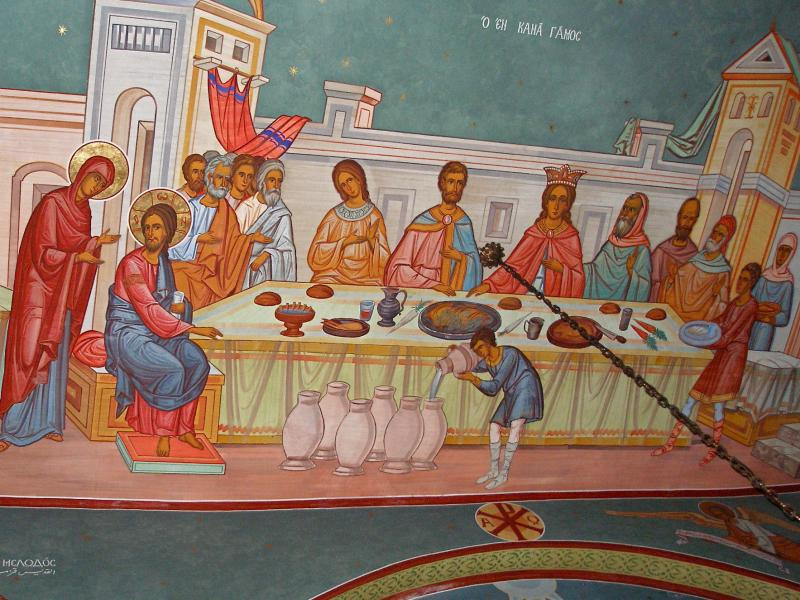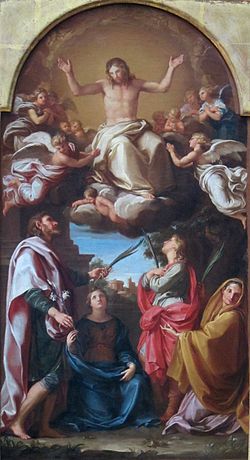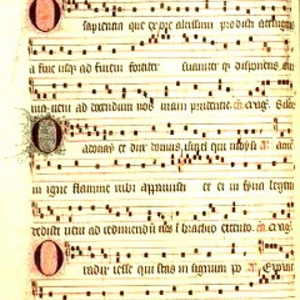 |
| Annunciation Cathedral (Jerusalem) : Fresco of Marriage at Cana. photo by See The Holy Land |
Last week I suggested that the Gospel for the Sunday within the former Octave of the Epiphany, on our Lord's teaching in the Temple at the age of twelve, relates to the idea of the twelve days of Christmas.
This week the Gospel is the story of the wedding at Cana, and it too includes some important number symbolism which I want to look at, particularly focusing on some possible links between the the six water jars of the Gospel, and the first of the Matins responsories for this Sunday, and whose text comes from Psalm 6.
In the twentieth century it was proposed that the core of the psalm based responsories used in this period actually represent a set of proto-responsories that were originally used throughout the year, and their ordering through the week was thought to attest to an earlier version of the Roman Office psalm cursus. [1]
I want to suggest that in fact these responsories were chosen, probably in the late seventh or eighth century, for their links to the season and the readings used in them. So today, a bit of a taster for my theory, looking at the first of the set.
When does Epiphanytide end?
In both the Roman and Benedictine Offices, the 'ordinary' of the Office reverts, this week, to 'time throughout the year (aside for the Marion cycles at Compline, and in the Office of Our Lady on Saturday).
As Gregory DiPippo has pointed out over at New Liturgical Movement, however, in a useful post on when the Christmas season ends, the Gospels over the next few Sundays (as well, it should be noted, as the Propers at Mass) all continue to reflect the key themes encapsulated in the feast of the Epiphany.
This Sunday for example, the Gospel is the miracle performed at the wedding at Cana, one of the three events explicitly commemorated in the feast as a public 'manifestation of Christ's glory':
And the third day, there was a marriage in Cana of Galilee: and the mother of Jesus was there. And Jesus also was invited, and his disciples, to the marriage. And the wine failing, the mother of Jesus saith to him: They have no wine. And Jesus saith to her: Woman, what is that to me and to thee? my hour is not yet come. His mother saith to the waiters: Whatsoever he shall say to you, do ye.
Now there were set there six waterpots of stone, according to the manner of the purifying of the Jews, containing two or three measures apiece. Jesus saith to them: Fill the waterpots with water. And they filled them up to the brim. And Jesus saith to them: Draw out now, and carry to the chief steward of the feast. And they carried it. And when the chief steward had tasted the water made wine, and knew not whence it was, but the waiters knew who had drawn the water; the chief steward calleth the bridegroom, And saith to him: Every man at first setteth forth good wine, and when men have well drunk, then that which is worse. But thou hast kept the good wine until now.
This beginning of miracles did Jesus in Cana of Galilee; and manifested his glory, and his disciples believed in him.The wedding and the Christmas season
There is a lovely sermon on this Gospel by St Bede, which explains the mystical significance of the wedding, and its links to the Nativity:
Christ descended from heaven to earth in order to connect the Church to himself in spiritual love. His nuptial chamber was the womb of his Incorrupt mother...and from their he came forth like a bridegroom to join the Church to himself. [2]St Bede also nicely links together the whole of the greater Christmas season:
As the sixth age of the world began, the Lord appeared in the flesh [Christmas]; on the eighth day after his nativity he was circumcised in accordance with the law [Octave of Christmas]; on the thirty-third day after this he was brought to the temple and the offerings stipulated by the law were made for him. [Feast of the Purification].The water jars transformed into wine at the wedding at Cana, he goes on to explain, represent 'knowledge of sacred scripture, which both cleanses its hearers from the stain of sin and gives [them] drink from the font of holy cognition', they contain 'the saving waters of the scriptures'.
And that there of six of them, he suggests, refers to the six ages of the world (from St Augustine - the first from Adam to Noah; the second from the Flood to Abraham; and so forth). Each of these eras, he suggests both foreshadows and is transformed for us by Christ: the Flood becomes baptism for example.
But the piece of number symbolism that I particularly draw you attention to is the link he makes between the number of jars and baptism on the 'eighth day':
Behold, the sixth hyria [water jar] [is] for cleansing the contagion of sin, for giving drink from the joys of life, and for bringing cleaner flowing waters to others. But in the circumcision of the eighth day you may understand baptism, which has redeemed us from the death of our sins into the mystery of the Lord's resurrection.The Matins responsories: Psalm 6
It seems to me that this symbolism helps explain the choice of the Psalm used in the first Matins responsory for this Sunday, Domine ne in ira tua.
The meaning of psalm numbers
First consider the significance of the number of the psalm - Psalm 6; 6 water jars. ,
We tend to be oblivious to the significance the Fathers gave to the number of psalms, since these days every book of Scripture is divided into chapters and assigned verse numbers.
But chapter and verse numbers are in fact largely an early modern invention; originally only the psalms had 'chapter' numbers and the Fathers considered these to be part of the inspired text. Accordingly, Patristic psalm commentaries often point to their significance in the context of the content of the psalm. St Benedict's contemporary Cassiodorus, for example, comments that:
It is not without significance that he set the character of the penitent within the number six, which is acknowledged as perfect in the discipline of numbers.
On the sixth day God created man; in the sixth age, the Lord Christ deigned to come into the world for the salvation of men, so that this reckoning seems to embrace both man's beginning and the absolution of his sins. [3]Psalm 6 is the also first of the penitential psalms, and so the emphasis St Bede places on the transformation of the water into wine as signifying the cleansing of our sins is therefore particularly appropriate, and reflected in several of the other (psalmic and non-psalmic) responsories used over this week. Indeed, Pope Sergius I (650-701) instituted an early morning procession before Mass on the Feast of the Purification, at which black vestments were worn, to mark the end of the season.[4]
Psalm titles
The second link is the reference St Bede makes back to the eighth day, the Circumcision of Our Lord, and its baptismal associations.
Psalm 6 has the following title in the vulgate: 'In finem, in carminibus. Psalmus David. Pro octava', or 'Unto the end, in verses, a psalm for David, for the octave'.
While modern interpreters either ignore the titles altogether, or take them very literally, the Fathers devoted a great deal of consideration to their allegorical meanings.
And several Patristic commentaries, including that of the fifth century Roman monk Arnobius Junior, interpreted the reference to the 'octave' in the title of Psalm 6 as a reference to circumcision and baptism, a theme they saw reflected symbolically in the verse of Psalm 6 where the psalmist speaks of floods of tears drenching his bed each night.
The second responsory: Psalm 9
Now all of the above could be dismissed if the links to the season ended with the first responsory.
In fact, however, if we look at the responsories set for the Sundays in Epiphanytide through the lens of Patristic interpretations, similar linkages can be found for all of the responsories set for these Sundays.
Consider, for example the second of the set, which uses verses from Psalm 9.
The Vulgate gives the title of Psalm 9 as 'In finem, pro occultis filii. Psalmus David', or 'Unto the end, for the hidden things of the Son. A psalm for David.'
St Augustine's commentary on the psalm links this very directly to the idea of the manifestation, or epiphany of Christ:
What then are the hidden things of the Son? By which expression we must first understand that there are some things of the Son manifest, from which those are distinguished which are called hidden. Wherefore since we believe two advents of the Lord, one past, which the Jews understood not: the other future, which we both hope for; and since the one which the Jews understood not, profited the Gentiles; For the hidden things of the Son is not unsuitably understood to be spoken of this advent, in which blindness in part is happened to Israel, that the fullness of the Gentiles might come in. (Enarrations on the Psalms)That the final sentence of St Augustine's commentary on the Psalm (referencing Romans 11) also links very neatly to the first Nocturn readings of Matins during this period, which are from the Epistles of St Paul.
Indeed, as it turns out, St Augustine's commentaries on the psalms, and his extensive use of St Paul's Epistles (which were read at Matins during this period) in them, are quite central, I think, to this whole story. But more on this anon...
References
[1] R. Le Roux: ‘Etude de l’office dominical et férial: les répons “de psalmis” pour les matines de l’Epiphanie à la Septuagésime selon les cursus romain et monastique’, EG, vi (1963), 39–148. The most recent version of this theory was summarised by Laszlo Dobszay in 'The Divine Office in History', in T&T Clark Companion to Liturgy, Alcuin Reid (ed), esp pp 217-9.
[2] This and subsequent quotes are from Homily 1.14 in Bede the Venerable, Homilies on the Gospels, Book I, translation by Lawrence T Martin and David Hurst, Cistercian Studies 110, 1991).
[3] Cassiodorus: Explanation of the Psalms, vol 1, trans P G Walsh, Ancient Christian Writers series, 1991.
[4] Ordo Romani I




